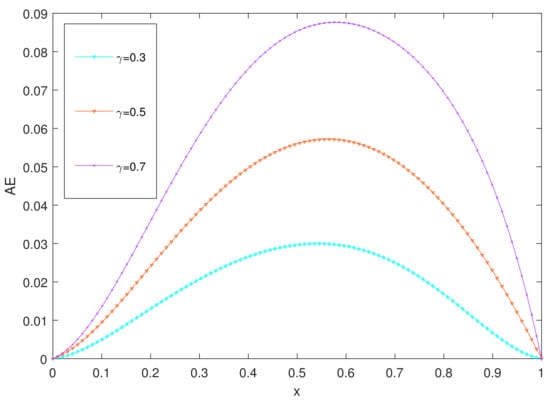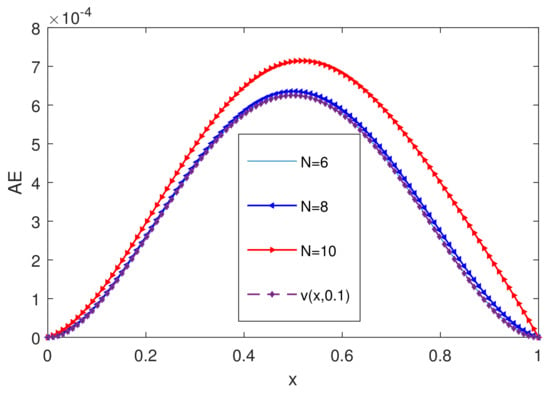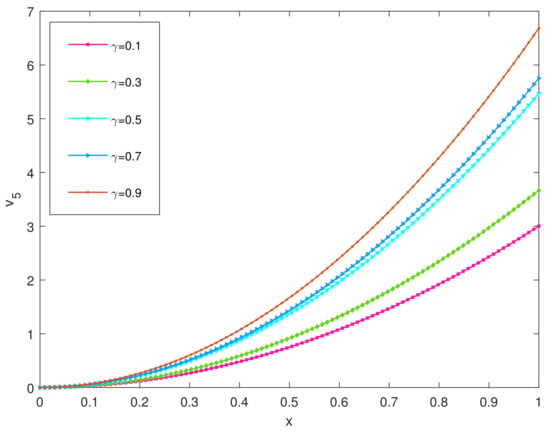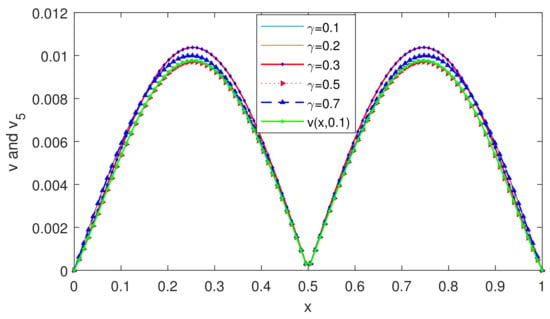Abstract
In this paper, an approximate method combining the finite difference and collocation methods is studied to solve the generalized fractional diffusion equation (GFDE). The convergence and stability analysis of the presented method are also established in detail. To ensure the effectiveness and the accuracy of the proposed method, test examples with different scale and weight functions are considered, and the obtained numerical results are compared with the existing methods in the literature. It is observed that the proposed approach works very well with the generalized fractional derivatives (GFDs), as the presence of scale and weight functions in a generalized fractional derivative (GFD) cause difficulty for its discretization and further analysis.
1. Introduction
Fractional calculus (FC) is an important branch of applied mathematics, which deals with the arbitrary order derivative and integration [,,,,]. Its applications in different fields are seen in biophysics [], engineering [], fluid mechanics and bioengineering [,] and other areas including image processing [,,,]. Most of these studies are mainly based on the traditional fractional derivatives, such as the Riemann–Liouville fractional derivative and the Caputo fractional derivative, etc. Recently, in [] Agrawal discussed a new GFD, which generalized the traditional derivatives using weight and scale functions. The scale functions were used to compress and enlarge the domain for the close observation of physical phenomena, while the weight functions provide flexibility for the researchers to assess physical events at different times. Due to such behaviors of the scale and weight functions, the study of fractional partial differential equations (FPDE) using a GFD has attracted researchers in recent years. Several authors have developed numerical schemes for solving FPDEs involving GFDs. Here, we cite only few of them. In [,], Agrawal and coauthors presented the numerical solutions to the Berger’s equation and the fractional advection–diffusion equation (FADE) with a generalized time-fractional derivative for the first time. The numerical solutions to these problems were obtained using the finite difference method. Further, the authors of [,], studied the time-fractional telegraph equations and fractional advection–diffusion equations in terms of GFDs and developed the higher order schemes to solve such equations. Kumar et al. [] presented two numerical schemes to approximate the GFDs and obtained the convergence orders as and , respectively. Further, these schemes were applied to solve the fractional integro-differential equations defined in terms of GFDs. In [], Kumari and Pandey proposed an approximation method with a order of convergence to approximate GFDs and applied it to solve the fractional advection–diffusion equations. Li and Wong [] discussed a numerical scheme to find the solution of the generalized subdiffusion equation. Here, the authors used the generalized Grunwald–Letnikov approximation method to solve the problem. Some other recently presented methods for solving different types of fractional diffusion equations are summarized as follows: in [], the authors discussed the matrix method for the reaction–diffusion equation that involved the Mittag–Leffler kernel. Duan et al. [] solved the convection–diffusion equations using the Shannon–Runge–Kutta–Gill method. In [], the authors discussed the solution to the fractional subdiffusion and the reaction–subdiffusion equations with a nonlinear source term using the Legendre collocation method. Lin and Xu [] solved the time-fractional diffusion equation (TFDE) using the spectral method and finite difference method (FDM). In [], Murio solved the time-fractional advection–diffusion equation (TFADE) by using implicit FDM. Sweilam et al. [] developed the Crank–Nicolson FDM to solve a linear TFDE defined with a Caputo fractional derivative. In [], Luchko solved the initial value and boundary value multi-term TFDE using the Fourier series method. Dubey et al. [] proposed a residual power series method to obtain the solution of homogeneous and nonhomogeneous nonlinear fractional order partial differential equations.
In this paper, we study the generalized fractional diffusion equation (GFDE) obtained from the standard diffusion equation by replacing the first-order time derivative term with a fractional derivative of order , given as,
with initial and boundary conditions,
where is the source/sink function.
The motive of this paper is to construct an efficient method to obtain the numerical solution to the GFDE. The present method is based on the finite difference and collocation methods with Jacobi polynomials as the basis function. The outline of the paper is as follows: In Section 2, we discuss some basic facts about FC and Jacobi polynomials, which are needed throughout this paper. In Section 3, first, the finite difference method is used to discretize the time derivative. Second, on the space variable, we use the collocation method for numerical approximation. Further, we estimate the error and convergence analysis analytically, which ensures the numerical applicability of the proposed method. In Section 5, we present two numerical examples to validate the proposed method. Furthermore, we compare our results with a few other methods from the literature, which are presented in Section 5. Finally, in Section 6, the conclusions are discussed.
2. Preliminaries of Fractional Calculus and Jacobi Polynomials
In this section, we discuss some preliminary facts and basic properties of generalized fractional calculus and Jacobi polynomials [,].
2.1. Generalized Fractional Calculus
Definition 1
([]). The Caputo derivative of a function of order γ is defined as
where and .
Definition 2
([]). A generalized fractional derivative of order of a function with respect to weight function and scale function is defined as
Definition 3.
A generalized fractional integral of a function of fractional order is defined as
Definition 4
([]). The left/forward generalized Caputo fractional derivative of order of function with respect to weight function and scale function is defined by
where .
For a particular choice of the weight and scale functions , Equation (6) reduces to the Caputo derivative. We have considered the weight and scale sufficiently good such that the integral exists in GFD.
2.2. Jacobi Polynomials
Definition 5.
The Jacobi polynomials [] for indices and degree n are the solutions of the Sturm–Liouville problems. These are orthogonal polynomials with respect to the Jacobi weight function in interval , defined as follows:
The kth derivative of Jacobi polynomials defined as
satisfy the recurrence relation
where
and
For the transformation of the interval to , we use the relation, . The recurrence relation (9) becomes
where
It satisfies the orthogonality relation
where is the Kronecker delta function, is the weight function, and
The summation form of the Jacobi polynomials is written as
and the pth derivative of Equation (13) in , can be further rewritten in terms of x as
The value of the shifted Jacobi polynomials at the end points are given as
Let be a square integrable function defined on , then
where are the unknown coefficients determined by the relation
Truncating the series in Equation (16) up to terms, the approximation of is given as
3. Numerical Scheme and Stability Analysis
3.1. Discretization in the Time Direction
For the discretization of the GFD, we follow the discretization process as discussed in Refs. [,]. We split the time interval into equal parts having step size , , and choose the node points as with starting point . Assuming , and is a monotonic increasing function on , such that ; then, . The discretization of the GFD of at node is given as
where
and is the truncation error given by
Lemma 1.
The coefficient given by Equation (20), satisfies
Proof.
For the proof of Lemma 1, see Ref [].
3.2. Approximation in Space Direction
We apply the collocation method to approximate the spatial domain of Equation (1) with Jacobi polynomials. We consider the approximate solution of the form,
From Equations (1), (19), and (22), we have the semi-discretized scheme as follows
where denotes the error term in the space direction arising due to replacing with .
Neglecting the error part, we obtain the fully discretized scheme of Equation (1) by the collocation method [,]. We choose the collocation points such that the stability is unchanged. So, we choose the collocation point of the form , which are the roots of the nth degree Jacobi polynomials, and , are the boundary conditions. Thus, for it holds that
and the initial and boundary conditions become
4. Error and Convergence Analysis
In this section, we discuss the error and convergence analysis of the proposed numerical method for Equation (1). We prove the error and convergence analysis analytically with the help of the following lemma and theorems.
Lemma 2
([]). The truncation error defined by Equation (21) satisfies
where is the approximating function, is the weight function at node for , and is the Lipschitz constant on the interval .
Proof.
For the detailed proof of this lemma, we refer to [].
Theorem 1.
The error in approximation of the function by the first m terms of the series in Equation (16) is bounded by the sum of the absolute values of all the neglected coefficients in the series, i.e.,
and
Proof.
The proof is trivial since and .
Theorem 2.
Let be the square integrable function defined on and , where is constant. Then, the can be expanded with an infinite sum of Jacobi polynomials, and the infinite series converges to uniformly, i.e.,
where
and 0.
Proof.
From Equations (16) and (18), we have
where are the unknown coefficients. Furthermore, from Equation (17), we obtain
Hence, the series converges to uniformly.
Theorem 3.
Let be times differentiable function defined on interval . Let be the approximation of , then
where , and denote the incomplete Beta function. At , it reduces to the standard Beta function.
Proof.
By the Taylor series expansion, we have
where and . Let
then
Since, we assume that is the best square approximation of , we have
Hence,
Theorem 4.
Proof.
The proof of this theorem is similar to the Theorem 1 of []. In [], the authors proved the stability for the time-fractional KdV equation. Here, we extend the proof for the time-fractional diffusion equation. To prove Theorem 4, we first rewrite Equation (26) over the summation up to time step in discrete form. Thus, we have
where , and .
Let , and is the polynomial of degree satisfying . Multiplying both sides of Equation (41) by , and taking the summation on i from 0 to , we have
where is the corresponding weight function. Since the degree of (x) does not exceed , then from Equation (11),
It can be easily shown that
Now, the discrete form of the Equation (42) at the nodes can be rewritten as
by using the Cauchy–Schwartz inequality and Lemma (1). The remaining part of the proof can be completed following similar steps to those shown in Theorem 1 of [].
5. Numerical Results
In this section, we provide two numerical examples to validate the presented finite difference–collocation method. In the given examples, we calculate the maximum absolute error (MAE), absolute error (AE), and the order of convergence (CO) for each example. With the help of the MAE and CO, we analyze the error and convergence analysis numerically. Furthermore, we have plotted the graphs of the numerical solutions by changing the various parameters of , and scale function . For the numerical simulations, we take the weight function . All numerical simulations were performed with Mathematica software.
The MAE at time t is given by
and the order of convergence is defined by
where and are the exact and approximate solutions, respectively. and are the MAEs for two consecutive values and .
Example 1.
Here, we consider the generalized version of the problem given in [] as
the initial and boundary conditions are given by
The exact solution of Example (1) is This problem is solved for various values of , and t. In Table 1 and Table 2, we compare the results obtained by our technique to the given methods in [,,] at . We observed that the results obtained by the present method (PM) provided a better approximation for this problem. In Table 3, we have discussed the MAE and CO for various values of and . Further, in Figure 1, we plotted the AE comparison graphs for different values of and observe that the numerical approximation showed good agreement with the exact solution. Figure 2 shows the behavior of the AEs for various values of with a fixed . We observe from Figure 2 that the numerical solution at showed good agreement with the exact solution at . Finally, in Figure 3, we plotted the numerical solutions for the various values of for a fixed value of .

Table 1.
Comparison of MAE for Example 1 with .

Table 2.
Comparison of MAE for Example 1 with .

Table 3.
The CO and MAE for Example 1 with various values of and .

Figure 1.
Comparison of AE at , and different values of for Example 1.

Figure 2.
Plot of AE for different values of at and for Example 1.

Figure 3.
Comparison of the numerical solution for different values of at and for Example 1.
Example 2.
Consider the following Example [],
where
with the initial and boundary conditions given by,
The exact solution for this Example (2) is .
We shall apply the numerical scheme (26) to solve this problem (2) for different values of with varying the fractional order . We obtain the AEs at the grid points in the given domain, which are shown in Table 4 and Table 5, respectively. The results presented in Table 4 and Table 5 establish the convergence of the proposed method for different values of . In Table 6, we show the MAE by varying the different values of and . Further, we show the CO for each value of , which proves the accuracy of the present method. In Figure 4, we compared the numerical solutions for various choices of with the exact solution known at . In Figure 5, the solution graphs for different values of and plot of the exact solution (for ) are shown. From Figure 4 and Figure 5, we conclude that the numerical solution obtained by the proposed method converges to the exact solution. Finally, we compared our results with the existing method [] in Table 7. We see that the proposed method gives better accuracy in approximating the numerical solutions.

Table 4.
Comparison of AE for Example 2 at and various values of .

Table 5.
Comparison of AE for Example 2 at and various values of .

Table 6.
The MAE and CO for Example 2 for various values of and .

Figure 4.
Comparison of the numerical and the exact solution at and different values of for Example 2.

Figure 5.
Plot of the numerical solutions for different values of at for Example 2.

Table 7.
Comparison of the MAE of Example 2 with .
6. Conclusions
A numerical scheme for a new class of fractional diffusion equation was studied in this paper in which the time derivative was considered as the generalized fractional derivative. The scheme used the finite difference and collocation methods to find the numerical solution. The theoretical error and convergence analysis were also validated numerically. The numerical examples showed that the proposed method achieved high accuracy in comparison to other methods [,,,] presented recently.
Author Contributions
Conceptualization, S.K. (Sandeep Kumar) and R.K.P.; methodology, S.K. (Sandeep Kumar), K.K. and R.K.P.; software, S.K. (Sandeep Kumar) and R.K.P.; validation, S.K. (Sandeep Kumar), K.K. and R.K.P., writing—original draft preparation, S.K. (Sandeep Kumar), K.K., R.K.P., S.K. (Shyam Kamal) and T.N.D.; writing—review and editing, R.K.P., S.K. (Shyam Kamal) and T.N.D.; supervision, R.K.P.; funding acquisition, R.K.P., S.K. (Shyam Kamal), and T.N.D. All authors have read and agreed to the published version of the manuscript.
Funding
This research received no external funding.
Data Availability Statement
Not applicable.
Acknowledgments
The authors sincerely thank the reviewers for their constructive comments to improve the manuscript.
Conflicts of Interest
The authors declare no conflict of interest.
References
- Podlubny, I. Fractional Differential Equations: An Introduction to Fractional Derivatives, Fractional Differential Equations, to Methods of Their Solution and Some of Their Applications; Elsevier: Amsterdam, The Netherlands, 1998. [Google Scholar]
- McBride, A. V. Kiryakova Generalized fractional calculus and applications (Pitman Research Notes in Mathematics Vol. 301, Longman1994), 388 pp., 0 582 21977 9,£ 39. Proc. Edinb. Math. Soc. 1995, 38, 189–190. [Google Scholar] [CrossRef] [Green Version]
- Podlubny, I. An introduction to fractional derivatives, fractional differential equations, methods of their solution and some of their applications. Math. Sci. Eng. 1999, 198, 340. [Google Scholar]
- Miller, K.S.; Ross, B. An Introduction to the Fractional Calculus and Fractional Differential Equations; Wiley: Hoboken, NJ, USA, 1993. [Google Scholar]
- Cattani, C.; Srivastava, H.M.; Yang, X.J. Fractional Dynamics; De Gruyter Open: Warsaw, Poland, 2016. [Google Scholar]
- Hilfer, R. Applications of Fractional Calculus in Physics; World Scientific: Singapore, 2000. [Google Scholar]
- Hassani, H.; Avazzadeh, Z.; Machado, J.A.T. Solving two-dimensional variable-order fractional optimal control problems with transcendental Bernstein series. J. Comput. Nonlinear Dyn. 2019, 14, 061001. [Google Scholar] [CrossRef]
- Li, X.; Chen, X.D.; Chen, N. A third-order approximate solution of the reaction-diffusion process in an immobilized biocatalyst particle. Biochem. Eng. J. 2004, 17, 65–69. [Google Scholar] [CrossRef]
- Magin, R. Fractional calculus in bioengineering, part 1. Crit. Rev. Biomed. Eng. 2004, 32, 1–104. [Google Scholar] [CrossRef] [PubMed] [Green Version]
- Baleanu, D.; Sajjadi, S.S.; Jajarmi, A.; Asad, J.H. New features of the fractional Euler–Lagrange equations for a physical system within a non-singular derivative operator. Eur. Phys. J. Plus 2019, 134, 181. [Google Scholar] [CrossRef]
- Bagley, R.L.; Torvik, P. A theoretical basis for the application of fractional calculus to viscoelasticity. J. Rheol. 1983, 27, 201–210. [Google Scholar] [CrossRef]
- Carpinteri, A.; Mainardi, F. Fractals and Fractional Calculus in Continuum Mechanics; Springer: Berlin/Heidelberg, Germany, 2014; Volume 378. [Google Scholar]
- Shukla, A.K.; Pandey, R.K.; Pachori, R.B. A fractional filter based efficient algorithm for retinal blood vessel segmentation. Biomed. Signal Process. Control 2020, 59, 101883. [Google Scholar] [CrossRef]
- Agrawal, O.P. Some generalized fractional calculus operators and their applications in integral equations. Fract. Calc. Appl. Anal. 2012, 15, 700–711. [Google Scholar] [CrossRef]
- Xu, Y.; Agrawal, O.P. Numerical solutions and analysis of diffusion for new generalized fractional Burgers equation. Fract. Calc. Appl. Anal. 2013, 16, 709–736. [Google Scholar] [CrossRef]
- Xu, Y.; He, Z.; Xu, Q. Numerical solutions of fractional advection–diffusion equations with a kind of new generalized fractional derivative. Int. J. Comput. Math. 2014, 91, 588–600. [Google Scholar] [CrossRef]
- Kumar, K.; Pandey, R.K.; Sharma, S.; Xu, Y. Numerical scheme with convergence for a generalized time-fractional Telegraph-type equation. Numer. Methods Partial Differ. Equ. 2019, 35, 1164–1183. [Google Scholar] [CrossRef]
- Yadav, S.; Pandey, R.K.; Shukla, A.K.; Kumar, K. High-order approximation for generalized fractional derivative and its application. Int. J. Numer. Methods Heat Fluid Flow 2019, 29, 3515–3534. [Google Scholar] [CrossRef]
- Kumar, K.; Pandey, R.K.; Sultana, F. Numerical schemes with convergence for generalized fractional integro-differential equations. J. Comput. Appl. Math. 2021, 388, 113318. [Google Scholar] [CrossRef]
- Kumari, S.; Pandey, R.K. High-order approximation to generalized Caputo derivatives and generalized fractional advection-diffusion equations. arXiv 2022, arXiv:2206.04033. [Google Scholar]
- Li, X.; Wong, P.J. A gWSGL numerical scheme for generalized fractional sub-diffusion problems. Commun. Nonlinear Sci. Numer. Simul. 2020, 82, 104991. [Google Scholar] [CrossRef]
- Heydari, M.; Atangana, A.; Avazzadeh, Z.; Mahmoudi, M. An operational matrix method for nonlinear variable-order time fractional reaction-diffusion equation involving Mittag–Leffler kernel. Eur. Phys. J. Plus 2020, 135, 237. [Google Scholar] [CrossRef]
- Duan, X.; Leng, J.; Cattani, C.; Li, C. A shannon-runge-kutta-gill method for convection-diffusion equations. Math. Probl. Eng. 2013, 2013, 163734. [Google Scholar] [CrossRef]
- Bhrawy, A.H.; Baleanu, D.; Mallawi, F. A new numerical technique for solving fractional sub-diffusion and reaction sub-diffusion equations with a nonlinear source term. Therm. Sci. 2015, 19, S25–S34. [Google Scholar] [CrossRef]
- Lin, Y.; Xu, C. Finite difference/spectral approximations for the time-fractional diffusion equation. J. Comput. Phys. 2007, 225, 1533–1552. [Google Scholar] [CrossRef]
- Murio, D.A. Implicit finite difference approximation for time-fractional diffusion equations. Comput. Math. Appl. 2008, 56, 1138–1145. [Google Scholar] [CrossRef]
- Sweilam, N.; Khader, M.; Mahdy, A. Crank-Nicolson finite difference method for solving time-fractional diffusion equation. J. Fract. Calc. Appl. 2012, 2, 1–9. [Google Scholar]
- Luchko, Y. Initial-boundary-value problems for the generalized multi-term time-fractional diffusion equation. J. Math. Anal. Appl. 2011, 374, 538–548. [Google Scholar] [CrossRef] [Green Version]
- Dubey, V.P.; Kumar, R.; Kumar, D.; Khan, I.; Singh, J. An efficient computational scheme for nonlinear time-fractional systems of partial differential equations arising in physical sciences. Adv. Differ. Equ. 2020, 2020, 46. [Google Scholar] [CrossRef]
- Oldham, K.; Spanier, J. The Fractional Calculus Theory and Applications of Differentiation and Integration to Arbitrary Order; Elsevier: Amsterdam, The Netherlands, 1974. [Google Scholar]
- Askey, R.; Wilson, J.A. Some Basic Hypergeometric Orthogonal Polynomials that Generalize Jacobi Polynomials; American Mathematical Soc.: Providence, RI, USA, 1985; Volume 319. [Google Scholar]
- Cao, W.; Xu, Y.; Zheng, Z. Finite difference/collocation method for a generalized time-fractional KDV equation. Appl. Sci. 2018, 8, 42. [Google Scholar] [CrossRef] [Green Version]
- Bellomo, N.; Lods, B.; Revelli, R.; Ridolfi, L. Generalized Collocation Methods: Solutions to Nonlinear Problems; Springer Science & Business Media: Berlin/Heidelberg, Germany, 2007. [Google Scholar]
- Pirkhedri, A.; Javadi, H.H.S. Solving the time-fractional diffusion equation via Sinc–Haar collocation method. Appl. Math. Comput. 2015, 257, 317–326. [Google Scholar] [CrossRef]
- Saadatmandi, A.; Dehghan, M.; Azizi, M.R. The Sinc–Legendre collocation method for a class of fractional convection-diffusion equations with variable coefficients. Commun. Nonlinear Sci. Numer. Simul. 2012, 17, 4125–4136. [Google Scholar] [CrossRef]
- Momani, S. An analytical approximate solution for fractional heat-like and wave-like equations with variable coefficients using the decomposition method. Appl. Math. Comput. 2005, 165, 459–472. [Google Scholar] [CrossRef]
- Molliq, Y.; Noorani, M.S.M.; Hashim, I. Variational iteration method for fractional heat-and wave-like equations. Nonlinear Anal. Real World Appl. 2009, 10, 1854–1869. [Google Scholar] [CrossRef]
- Chen, R.; Liu, F.; Anh, V. Numerical methods and analysis for a multi-term time-space variable-order fractional advection–diffusion equations and applications. J. Comput. Appl. Math. 2019, 352, 437–452. [Google Scholar] [CrossRef]
Publisher’s Note: MDPI stays neutral with regard to jurisdictional claims in published maps and institutional affiliations. |
© 2022 by the authors. Licensee MDPI, Basel, Switzerland. This article is an open access article distributed under the terms and conditions of the Creative Commons Attribution (CC BY) license (https://creativecommons.org/licenses/by/4.0/).